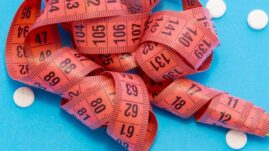We all know what tends to happen after a successful diet, right? We go back to eating like we used to (and perhaps even have a few cheat meals with the foods we have missed the most), and in no time, our weight is back to where it was before we started dieting.
Even if we do everything right, don’t pig out, and just eat enough healthy foods to get the calories we need to maintain our new weight, the sudden jump in calorie intake can make us put on a lot of unnecessary fat.
I know this feeling very well. After my fitness competition last year, I actually wanted to put some weight back on, so I just went straight back to eating normally (plus some…) and I gained a lot of unnecessary body fat in the process that I had to spend far too much time getting rid of again.
Right now, I’ve just finished four weeks of dieting for our October 27th photoshoot with NuFit, and this time my plan is to do everything right and not put the weight back on. That means Reverse Dieting.

What Is Reverse Dieting?
Reverse Dieting is a method to get back to a healthy and sustainable calorie intake after a period of dieting. The idea is to slowly add high-quality calories back into your diet and build up your metabolism to handle the calorie increase.
Let’s say you have been following a 1,300-calorie diet and want to get back to eating 1,800 calories/day (you can learn how to calculate your daily calorie need in this post). Your reverse diet would be to add perhaps 100-150 calories/day each week until you are at 1,800 calories/day. This means that you would be reverse dieting for three to five weeks, depending on how sure you want to be that you won’t put weight back on.
Reverse dieting is a very simple concept but not always easy to do. You naturally want to just end your diet when you reach your goal, and adding three or more weeks to it can seem like a lot. In fact, the reverse dieting phase is often harder for people to get through than the diet itself because you don’t have that clear goal of seeing your weight decrease to motivate you. I know it is for me, as I am not the most patient person when I don’t have a clear, short-term goal to follow.
The best way to think about reverse dieting is to decide up front that your diet simply isn’t over until you are back at a sustainable calorie intake without having put too much weight back on (you will always put on a little weight when you start eating more, so don’t worry If your weight increases 1-2 pounds from what it was when you ended the regular diet phase).
My Reverse Diet
I didn’t want to diet super hard, but, ultimately, I had to cut my calories back to about 1,350 per day for the last few weeks to get in the shape I wanted. I also added a lot of cardio, which anybody who knows me knows that I don’t do lightly (cardio is not my most favorite thing in the world). I lost almost 10 pounds in five weeks, which was perfectly in line with my goal.
Now, I want to get back to my old maintenance calorie intake of 2,000 calories or more per day. I have a healthy appetite and love to eat, so why not 😀

The shoot was on Tuesday and my plan is to stay at around 1,400 calories/day for the rest of this week (after we had one big burger dinner when we finished the shoot). I also won’t work out at all, because I want to give my body some rest.
The following week I’ll go back to lifting weights, but the cardio sessions are done for now. I plan on lifting heavy and increasing my calories to 1,500/day plus a weekly treat meal for the following month. I’ll then add in about 200 calories/day on a monthly basis after that. If I start gaining fat too quickly, I’ll scale back and let my body adjust. This is a very long reverse diet, but I have the time, so better safe than sorry. I am excited to see how that all pans out…
Should You Do Reverse Dieting?
If you have been dieting for a long time (or chronically under-eating), it’s probably not a good idea to shock your system by suddenly adding a lot of calories. On the other hand, if you use reverse dieting and continue to keep your diet 90-100% clean, your body might just welcome the extra calories.
There is really no reason not to use reverse dieting if you want to maintain all your hard-earned results and make a sustainable change to the way you look.




sam
I want to lose weight in a slow steady pace without ruining my metabolism and losing my period for several years like i did previously. So from my understanding, it seems that reverse dieting would be used when you were in a caloric deficit to lose weight but want to increase to your new maintenance calories? Would a healthy way, without damaging my metabolism or losing my period, to lose weight would be to be in a 100 caloric deficit for several weeks and once I lose five pounds (how much i want to lose), I would slowly increase to the amount of calories where I won’t lose or gain weight?
Christel Oerum
If you have the patience for it you can start with a limited calorie deficit. From a straight-up math perspective/rule of thumb, a 100 calorie deficit a day leads to a fat loss of less than a pound a month. With realistic expectations and a solid plan, you should be able to get to your goal in a healthy way.
Lindsey
I have no apitite at all and go for days without eating I’m also four stone over weight.. depression and eating chocolate for two years .. the depression has lifted the four stone hasn’t.. how do I even begin to sort this out I’m at my wits end thankyou
Christel Oerum
Based on your description your under and overeating is tied into your mental health. That’s not something I specialize in or feel comfortable guiding you on. If you can I’d suggest finding a coach or medical professional who can work with you, focusing on both mental health and physical health
Dani C
Hi, about 3 years ago I restricted my calorie intake and this past 2 years I managed to increase it, however, I want to keep increasing my caloric intake, but with minimum or no weight gain at all (no more than 1kg). How should I increase my calories from 1490 to 1590 (100+) in 1.5 weeks, should I just increase the 1oo calories and keep it for 1.5 weeks or should I slowly increase my calories so that when that amount of time passes I reach 1590. Please help me.
Btw I think this article is really helpful
Dani C
In the past, I’ve done this when I was in 1480kcal, but I could only increase it to 1490kcal and it made me gain around 1kg, so that is why I´m asking this because last time it didn’t work as it claimed to.
Christel Oerum
There are different theories on how to increase calories. When it’s only 100 calories we’re talking about I’d just jump up to the 159*0 and keep it there for a while until increasing further
Mary
I´m 1.70cm tall, I used to weight 55kg (which was weird because I could never gained weight, had always been 50kg my whole life, you know skinny but not muscular, somwhat toned, but then i turned 20 and i gained 5kilos in 1 month and a half) Im not used to looking at myself like this, so i started a weightloss plan where i eat 1000 calories a day (my BMR was 2000 so i substracted 1000 calories to loose 1kg of fat per week), I was told this was the better way to weight loss, its been 2 weeks and I´m at 53.5kg, which I think is ok, i looked a little bit more toned and less rounded, especially love hanldes and waist. So am happy, I was told to do this for 6 weeks, but after those six weeks (i hopefully be 50kg again but with muscle and low fat percentage) i dont know how many calories i need to eat to maintain my new wait! should i go back to 2000 by 100 calories a week? has my maintainance calories changed? for a female of 1.70cm that weights 50kg and its almost 21years old the BMR is 1350, and i plan to hit the gym 3 day a week and do a spin class 1 day a week, so i calculated my new maintainance calories at 1850. Is that reasonable? should i scale to 1850 by 100 calories a week?
Mary
sorry about the grammar, my keyboard is in spanish and changes stuff
Christel Oerum
You could add a few hundred calories at a time until you get to your maintenance calories. For example, start with upping it to 1500 calories, stay there for a week or two and then add another 100-200 calories at a time. That way you can see how your body is responding
hanna ramirez
Hi,
I’m a little unclear. If I want to increase by 50-100 calories, is that what I should be increasing per day, OR is that the total amount of calories I should increase per week?
In other words, for example, should I be adding 1tbsp of peanut butter per day OR an additional 1tbsp of peanut butter per day?
Thanks.
Christel Oerum
I would add back the 50-100 calories per day
Ang
I have been eating 1550 through my weight loss and I have lost 21kg, I have been increasing my calories by 100 each week however I’ve gained 0.6kg already and it’s really worrying me becasue I don’t want to gain weight, is this normal? Should I wait an extra week before adding more calories to see if that helps?
Christel Oerum
As you increase your overall calories and your carbs your body will bind more water (not a bad thing) and you will accumulate more waste in your system (more in more out). I wouldn’t worry too much about it, but there is nothing wrong with dialing it back 100 calories for a week or two if that makes you more comfortable
Manit Sinha
Thank you for sharing the information about the “Reverse Dieting”.
I learned a lot from it. I appreciate the detail you went into writing this blog post .I am grateful for the amount of time and effort you put into this helping us. By your results, I’m sure I will feel better after doing it!
Thanos
I have been on a diet for a long time(1600/day) and now im trying to get up to 2200 calories/day which as i calculated are my maintainance calories.I currently am at 1800 calories with neither weight gain nor fat gain.I have been adding 100 calories per week and was wondering if i could add 200 calories/week since my weight hasnt changed that much.In addition i would like to add a second question:Can i have 2 cheat days per month when im reverse dieting or will i have to wait until i reach the 2200+ calories(or more if able)
Christel Oerum
I think you can easily add in 200 calories, if you start to see weight gain you can always dial it back again for a little while. And for “treat meals”, as long as you’re not massively overeating but keeping your weekly calories in check you can have more
Katy
My teenager (18) hasn’t eaten more than a out 1200 to 1500 calories a day for some time and does 6 days a week running/gym sessions. She is putting on weight though (no treats or alcohol) and I am struggling to get more calories into her or to understand what is happening for her. Would reverse dieting help to rebalanced her metabolism?
She is also insulin resistant so not sure if that is playing a role. She isn’t overweight but has gained about 4 kg over the last few months with restricted eating.
Christel Oerum
If she truly is eating that little (including snacks outside the house and calorie beverages) and has gained 4 kg fast I’d suggest you see a doctor as that could be a symptom of hormone imbalance or something else.
To help with the insulin resistace she can try to include resistance training in her routine. And as for the daily calorie intake, it’s hard for me to say where she should be at, but eating very low calories for a long time can really stress the body out. She/you could try to keep her around the 1500 calories for a while and see how her body reacts, then add 100-200 calories and again see what happens. The hard part is the “see what happens” waiting game
Anna
I have been chronically undereating for a couple months at about 500 calories a day (crazy I know). I really want to go back to eating more but I don’t want to gain the weight back. I want to try reverse dieting but you said not to do it if you have been dieting for a long time or under eating which I have both? So my question is what should I do? I really need this and I cannot find a clear solution online anywhere. Also I eat VERY clean and natural foods so no junk food at all. Please reply as soon as possible and that k you for the article.
Best regards
Christel Oerum
What the article says is: “If you have been dieting for a long time (or chronically under-eating), it’s probably not a good idea to shock your system by suddenly adding a lot of calories.” With an emphasis on “a lot”. So instead of bumping up your calorie intake by 500 calories, try starting with 50-100 for a few weeks and continuing adding until you reach your maintenance calories (meaning the level where you don’t gain weight).